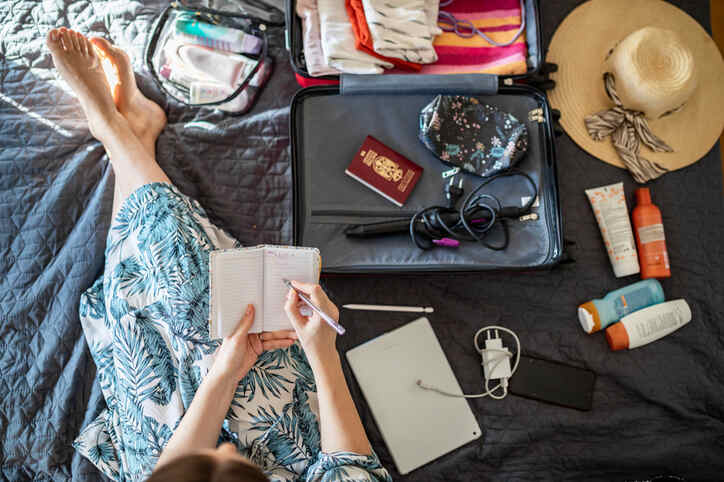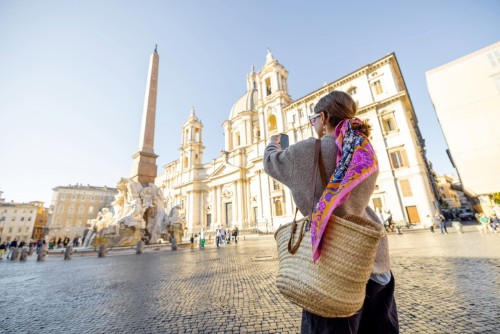Discover your Beginner's Guide to Solo Backpacking
Plan your first solo backpacking adventure with confidence with these tips on how to choose your destination, pack essential items, stay safe, and more.
Essential Guide to a Solo Backpacking
-
Solo backpacking is an exciting journey that leads you to self-discovery, personal growth, and freedom.
-
Traveling alone is very enriching, but you need to be prepared for some common risks, such as facing weather adversities, wildlife, or losing your way.
-
Planning a successful solo backpacking trip involves deciding the right place, managing the budget, carrying important gear, travel insurance, and learning about basic first aid.
Solo backpacking is a journey that can help you experience adventure while staying self-reliant. This is an opportunity to escape your daily life and transform yourself by traveling more. When you backpack alone, you will connect with a deeper sense of independence. Also, you can explore the beauty of mountains, wander through the remote coastlines, or explore the buzzing life of different cities around the world.
Backpacking solo is a chance to discover things at your own speed and know the world from your experience. This expert guide will give you all the reasons why you should go backpacking solo, along with the common risks and important tips for first-time travelers.
Why Go Solo Backpacking?
Traveling with just a backpack and yourself can be a wild and life-changing experience. Solo backpacking gets you out of your comfort zone. But you need to set realistic expectations for yourself to really get into it. Here are some reasons to solo backpack.
First, solo backpacking is an opportunity for personal growth and self discovery. Traveling alone allows you to dig deep into yourself, your values and your desires. This introspective journey will give you more self confidence and a sense of empowerment as you learn more about who you are.
Another big plus of solo travel is the freedom. You don’t have to coordinate with friends or a group so you’re the boss of your own adventure. You can set your own pace, choose your route, decide when and where to take breaks or side trails and have a super personalized experience.
Plus, solo backpacking can increase your chances of meeting new people. Contrary to the myth that traveling alone is isolating, it often opens up more opportunities to meet fellow travelers and locals. As a solo traveler you may find it easier to strike up conversations and make connections since you’re not part of a group.
How To Plan a Solo Backpacking Trip
So, this is your first solo backpacking trip? Don’t worry! You must take it one step at a time, and you’ll be all set for an amazing trip in the company of your backpack.
Decide Where to Go
Choosing your destination is one of the most exciting parts of planning a solo backpacking trip. You could start ticking off your list of "must-visit places." But before you get ahead of yourself, take into consideration a few factors like climate, budget and safety.
One option is to select a place you're already familiar with, like a destination you've visited before with friends or family. This can help ease any nerves you might have about going solo since you'll already know your way around and what to expect. Taking a solo car camping trip could be a good starting point to get some experience with solo trips.
If you want to try somewhere new, do plenty of research to find a place that aligns with your interests and comfort level. Look for destinations that are known to be safe and welcoming for solo travelers. Cities with vibrant hostel scenes, like many European capitals, can be great for meeting other backpackers. Or, if you prefer nature, consider national parks with well-marked trails and campgrounds like the Appalachian Trail, Yosemite National Park, the Rockies, and Big Sur in California.
Lastly, check out the safety record of the place where you are planning for your backpack expedition as a loner. Having an eye on local news, travel warnings, and crime levels helps you avoid compromising on your safety. Always check official travel advisories for safety information. Websites like the U.S. Department of State provide up-to-date travel advice to help you make informed decisions.
No matter where you decide to go, make sure it's a place you'll genuinely enjoy spending time in by yourself. The destination should excite you and make you curious to explore. Trust your instincts and pick somewhere that feels right for you.
Enlist Essential Items to Carry Along
Solo hiking is quite different from group backpacking. One reason is that you'll be relying on your own supplies, so it's important to pack carefully and efficiently. The basics you'll want to have are shelter (like a lightweight tent or tarp), a sleeping bag rated for the expected temperatures, and a sleeping pad for comfort and insulation. Bring plenty of water and a way to purify more if needed, like a filter or purification tablets. Pack high-energy, non-perishable foods that are easy to prepare.
Bring your smartphone along, as it's a valuable tool for staying connected and sharing your location with loved ones. Remember to pack power banks and chargers to keep your phone powered up. For added safety, pack individual accessories like a whistle, travel lock, and pepper spray. These items can help you feel more secure during your solo backpacking trip.
Had you been traveling in a group, you could divide up common items like cooking equipment, navigation aids, and other shared supplies to lighten each person's load. As a solo backpacker, you'll be carrying everything on your back. So, aim for lightweight and compact gear.
Pre-create an Itinerary
Make all your travel arrangements before you go and solo backpacking will be a breeze. Start by deciding how long you want to be on the trail and where you want to go. Research the trails, campsites and points of interest along the way.
Once you have a rough idea of your route, create a day-by-day itinerary with your start point, daily distances and where you’ll camp each night. This will help you with time management and give you direction and focus.
While you should stick to your itinerary, leave some room for spontaneity. Things don’t always go as planned, weather can change, or trail conditions can be different to what you expected, so be prepared to adjust if needed. On the flip side, you might meet other travelers who invite you on a last-minute adventure or discover a local festival you didn’t know about. Being flexible can lead to the best travel experiences.
Make sure to share your itinerary with a friend or family member before you go. That way someone will know your plans and can check in on you.
Plan for Emergencies
Being prepared for emergencies is a big part of solo backpacking. Start by writing down emergency contacts. Include local emergency numbers, the nearest embassy or consulate and contact details for family and friends. Keep these in your phone and a physical copy in your bag.
Know how to ask for help and what to do in different situations. If you’re going into areas with no cell service, consider carrying a satellite phone or personal locator beacon (PLB). These devices will allow you to call for help when you’re off the grid.
Lastly, get solo backpacking travel insurance as it can help you to deal with unexpected events like medical emergencies, loss of baggage, or trip cancellations. Also ensure that you have access to 24/7 emergency assistance services, including access to a helpline, coordination of medical services, and help with travel arrangements if needed.
How to Stay Safe on Solo Backpacking Trips
Solo backpacking is a lot of fun, but you need to follow some precautions for your safety. These risks can be getting lost, difficult weather conditions, encountering wildlife, lack of water, dehydration and fatigue, getting mugged, and harassment. Sometimes, you may also face certain scenarios that could put your life at risk. To avoid such circumstances, advance preparation is very important.
-
Prepare yourself for common health issues that may arise at your travel destination. It’s also wise to have a backpacking first aid kit with essentials like band-aids, antiseptic wipes, pain relievers and any personal medications you might need. Knowing basic first aid can also be incredibly helpful, so consider taking a course before your trip.
-
Once your itinerary is ready, share it with a trusted friend or family member. Include important details like contact information for accommodations and local emergency numbers. Consider using apps that allow real-time location sharing for added safety.
-
If you are spending a few nights camping, follow some safety tips. Camp at least 3-5 miles from trailheads, parking lots or roads to avoid unwanted attention from non-hikers.
-
If you are hitchhiking, choose populated areas and always inform someone about your route and the expected arrival time. Avoid getting into vehicles where more than one person is sitting inside.
-
Be aware of your limits, whether physical or mental. Be realistic about your daily mileage and don't overexert yourself, especially when carrying a heavy pack.
-
Trust your gut instincts when out and about while on your solo backpacking trip. If something doesn’t feel right, don’t hesitate to change your plans.
-
Purify drinking water by practicing water safety using portable filters. Store food to prevent contamination. Also, avoid consuming unfamiliar plants and wildlife.
-
Stay up-to-date with the required vaccinations for the region you are traveling to. Also, carry a well-stocked medication kit, which includes your personal medications and basic emergency supplies.
If you are a solo female backpacking, be more attentive to your surroundings. Research the risks associated with the activity or place you planned for and prepare yourself in advance for the same. Also, consider carrying self-defense items to enhance your safety, such as pepper spray, a portable door lock, personal alarms, safety whistles, a pocketknife, bear spray, a mini flashlight, and a slash-proof crossbody bag. These items can help you feel more secure and prepared during your solo trip.
Tips to Maximize Your Solo Backpacking Experience
Hitting the trail solo can be a fulfilling adventure. You may gain a new perspective on your journey. Here are some tips that will help you to get the most out of your first solo trip.
For your first solo backpacking trip you must start small and choose a well signed trail. for this, you must choose a destination with well-marked trails with signs, along with the availability of maps and emergency services. This will help you build confidence as you start your solo adventure.
Once you have chosen your solo backpacking route, prepare yourself emotionally and mentally. Set realistic expectations and practice self reliance and problem solving. It’s normal to feel lonely or homesick at times but never refrain from connecting with other travelers or locals.
You must also get involved in local customs and traditions to make the most of your trip. Learn a few basic phrases in the local language, try the local food and attend cultural events. It will allow you to experience the local life at its best.
To further this goal, you may also join local tours or other solo backpackers. Group travel will give you a sense of community and safety while you can share experiences and discover more about your destination.
You can also journal your trip to capture the emotions and experiences of your solo adventure. Write about your daily activities, the people you meet and your personal thoughts. This will not only hold your memories but also give you valuable insights for future trips.
Wherever you backpack to, practice sustainable travel to protect the environment and support local communities. Minimize waste by using reusables and disposing of waste properly. Choose ecofriendly transport, support local and sustainable businesses and follow Leave No Trace principles. Join local community projects or eco volunteering to promote ethical tourism and positively impact the places you visit.
FAQs About Solo Backpacking
1. How do you handle homesickness while traveling alone?
When traveling solo, homesickness is a very common feeling. So, you can carry along a few comforting items from home, such as photos of your loved ones or any souvenirs. Although being away from familiar faces, solo adventures provide wonderful opportunities for making friends with other hikers. You can also journal your feelings to process all your emotions.
2. How can I meet more travelers while solo backpacking?
Stay in guesthouses or hostels where you can meet new people and socialize. Join group tours, local meetups, or social media groups dedicated to travelers. Enjoy the local tourism, explore the city through walking tours, or enroll in some interesting activities.
3. How can I manage my budget while backpacking alone?
Cover the major areas like accommodation, transport, food, and gear in advance. Try to cook your own meals, use local transport, and consider walking when required. Use camping or hostels for your stay. If you are a first-time solo backpacker, try not to buy your personal gear; instead, rent the gear to reduce the expense.
4. Are there any non-lethal self-defense tools that are easy to carry in a backpack?
Yes, you can carry pepper spray, personal alarms, whistles, tactical pens, or mini flashlights. Such tools are small-sized and easily able to discourage any possible threats. However, you must cross-check if any of them are legally restricted in the country where you want to go backpacking.
5. What are essential solo backpacking skills?
Essential solo backpacking skills include navigation using maps and a compass, basic first aid to handle medical emergencies, and survival skills such as building a fire and finding clean water. Additionally, being able to set up camp and manage food storage to avoid attracting wildlife is crucial for safety.
Also Read: Backpacking, Solo Backpacking, How to plan Backpacking, Backpacking adventure, Backpacking Food, Backpacking Travel Insurance, Backpacking for Beginners

Get AXA Travel Insurance and travel worry free!
Travel Assistance Wherever, Whenever
Speak with one of our licensed representatives or our 24/7 multilingual insurance advisors to find the coverage you need for your next trip Get an instant quote!




